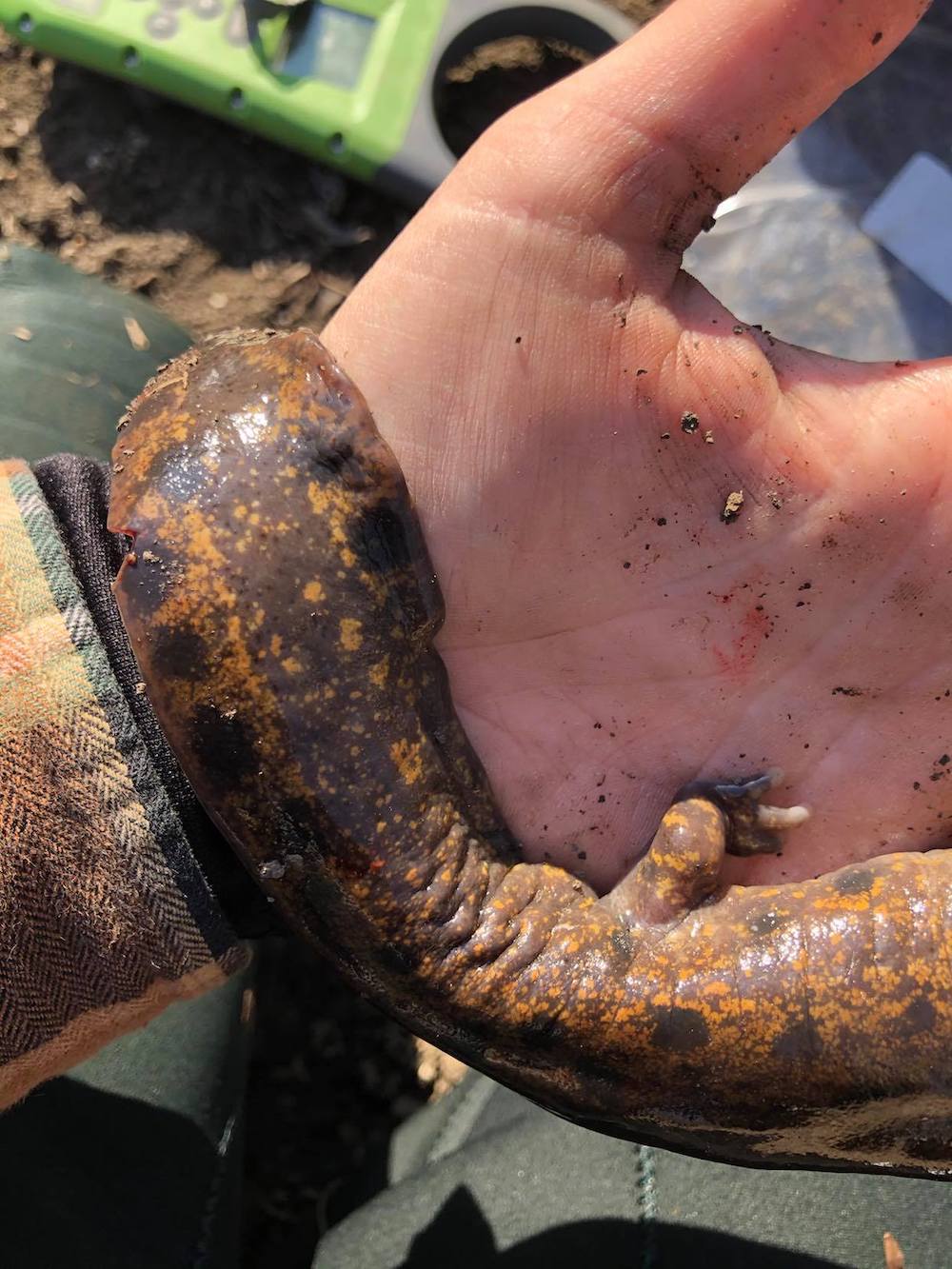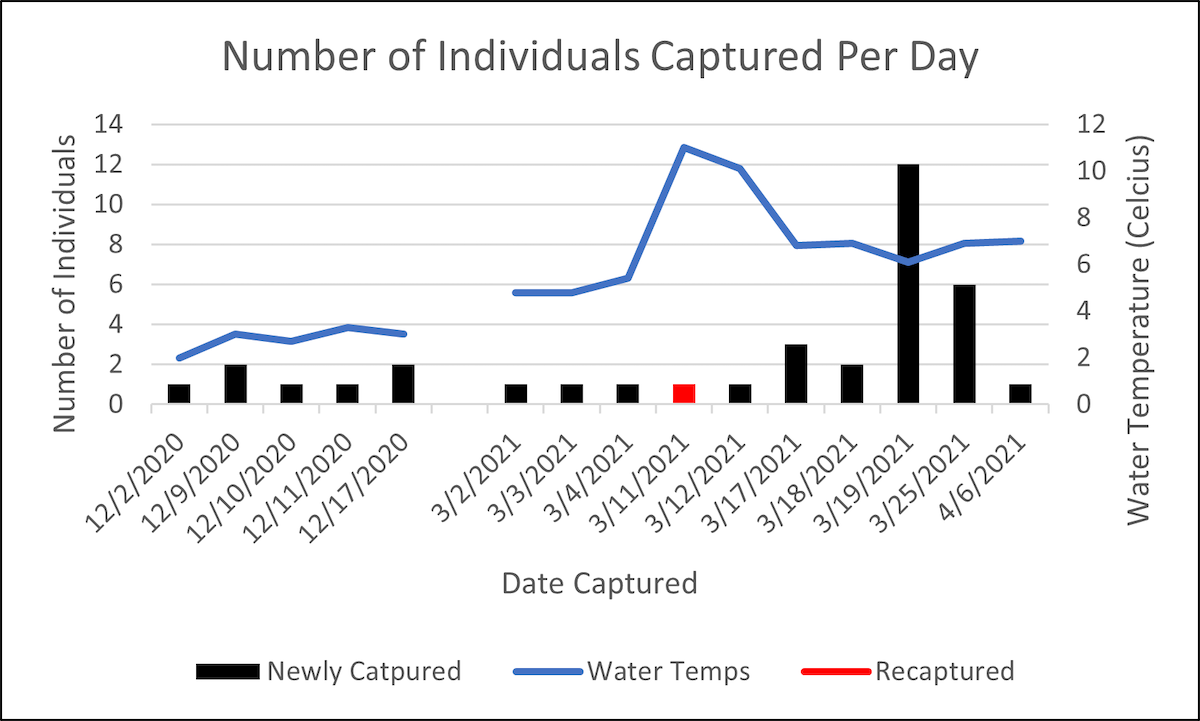
Image of a close-up view of a mudpuppy.



Image of a close-up view of a mudpuppy.
Photos by Alex Lourash, Natural Areas Manager at Allerton Park.
Map and graph by the author.
Hoisting the baited trap from the murky depths of the Sangamon River to find it glistening with thick mucus was a promising sign. As the trap reached the riverbank, bright red, feathery external gills stood out amongst the trapped decaying vegetative debris. A newly captured mudpuppy slowly attempted to wiggle free.

Freshwater species across the globe are currently facing unparalleled declining population rates due to stressors such as urbanization, invasive species, point source pollutants, habitat destruction, and climate change. The conservation of the mudpuppy (Necturus maculosus) in its native range is of high concern, given that they are obligate hosts for the salamander mussel (Simpsonaias ambigua), the only mussel in North America to use a non-fish host. Despite the mudpuppy’s wide distribution, information regarding the species’ populations and trends are lacking in most areas. Thus, more extensive monitoring efforts are needed to better understand the species’ population trends, conservation needs, and ecological relationships.
The mudpuppy (Necturus maculosus) is an entirely aquatic salamander that can weigh nearly 1 pound and obtain lengths up to 14 inches. The species is easily distinguished from other Illinois salamanders by their large, bushy red external gills and four, keratin-infused toes on their hind legs. Their coloration often ranges from light gray to brown and they have dark spots randomly distributed along their sides and tail. Mudpuppies have been observed in a multitude of habitats including muddy canals, large fast-flowing rivers, and large cool-water lakes. In Illinois, the mudpuppy primarily inhabits lakes, ponds, rivers, and large creeks with clear water, but they can survive in alternative habitats if rocky areas are available for reproduction.

The mudpuppy was listed as an Illinois threatened species in 2010 due to a decrease in recent observations within the state (Illinois Endangered Species Protection Board, 2011). The mudpuppy remains a state threatened species in Illinois and Iowa and is listed as a Species of Special Concern in other neighboring states. Though the mudpuppy remains a mysterious, understudied species, this amphibian species is the obligate host for the state-threatened salamander mussel. Despite whether the mudpuppy is listed as either endangered, threatened or a Species of Special Concern, it is important to continue research and conservation efforts to conserve and assist the success of both the mudpuppy and salamander mussel.
I collaborated with the Illinois Natural History Survey (INHS) to complete a mark and recapture study of the mudpuppy in an effort to gather baseline data about the species population size within the Sangamon River running through Robert Allerton Park in Monticello. Illinois Department of Natural Resources (IDNR) District Heritage Biologist (DHB) Eric Smith completed a presence-absence survey for the mudpuppy in 2016 and 2017 and confirmed the mudpuppy’s presence in Allerton Park as well as three tributaries of the Sangamon River (Wildcat Creek, Unnamed Creek and Willow Branch Creek). However, since Smith conducted a presence-absence survey, captured individuals were not marked and therefore it was difficult for Smith to confidently identify recaptured individuals or estimate the population size.

Four sites within Allerton Park were surveyed, which included the Old Levee Bridge that was previously surveyed by DHB Eric Smith in 2016. I intentionally chose to survey multiple locations to present an opportunity to estimate site-specific densities and present potential for individuals to move between locations. I actively trapped for a total of six weeks: three weeks at the beginning of the winter season as water temperatures began to drop and three weeks at the end of the season as water temperatures began to rise. The intention of splitting the trapping season was to explore if there was any relationship between capture rates and fluctuating water temperatures moving from one season to the next.
A combination of collapsible hoop traps and rectangular metal minnow traps were used and baited with either raw chicken liver or canned sardines. Ten traps were deployed at each of the four sites, five of each of the two trap styles. Traps were placed near locations identified as potential mudpuppy refugia, such as tree roots, fallen limbs or log jams. The traps were set for three traps nights and checked each day. Upon capturing a mudpuppy, each individual was weighed, measured, sexed, if possible, marked with a Passive Integrated Transponder (PIT) tag, and tail notched. The PIT tag is a minimally invasive radio transponder that contains a unique 15-digit identity number to help differentiate a newly captured mudpuppy from one that was recaptured.

The tail notch served two purposes in this research. First, notches were a secondary indicator of a recaptured individual should, on the rare occasion, the PIT tag fall out or get rejected. Secondly, it provided a tissue sample for DNA analyses to identify if there was any genetic relation between captured individuals. These analyses, paired with the mark-recapture data, will help biologists improve the assessment of the population within Allerton Park and better understand the mudpuppies habitat preferences overall.
Efforts resulted in a total of 36 newly captured mudpuppies and one recaptured individual. The overall mudpuppy catch rate for this research study was 1.85 mudpuppies/day and the calculated catch per unit effort was 0.462 mudpuppies/trap/day. With only one recaptured individual, the mudpuppy population size within Allerton Park cannot be confidently estimated. However, when comparing of the number of captured individuals to the fluctuation in water temperatures of the Sangamon River, there does not appear to be a direct relationship or significant trend across the duration of the research. As discharge levels spiked, a significant increase in the number of captured individuals was observed the following day, as seen on March 19, 2021. I hypothesize that with increased flow rates there is also an increase in the availability and accessibility to food, which then initiates a feeding frenzy and significant increase in mudpuppy capture rates.

In regard to future work, data from this research will keep the IDNR Natural Heritage Database current and support a future proposal for a State Wildlife Grant to fund statewide environmental DNA (eDNA) surveys for both the mudpuppy and salamander mussel. This research unexpectedly served as a pilot study for estimating mudpuppy populations and improving sampling protocols; thus, annual mudpuppy surveys in Allerton Park are imperative and would be substantial in identifying what factors directly influence mudpuppy capture rates. Despite its challenges, this research has proved significant in helping to refine mudpuppy sampling protocols and also contributed to the overall conservation of the species.

My name is Marissa Jones. I earned my bachelor’s and master’s degree in Environmental Science and a Geographic Information Systems (GIS) certificate from the University of Illinois Springfield. While completing my master’s degree, I gained two years of professional experience working in the Division of Natural Heritage at the Illinois Department of Natural Resources helping to map locations and record occurrences of endangered and threatened species and natural communities as they are located throughout Illinois. I am proudly working at Lincoln Memorial Garden as an Apprentice Gardener and learning from a knowledgeable mentor before taking over as Head Gardener in May 2022.
Submit a question for the author
Question: Please touch base. ASAP
My son found a mud puppy front leg in a pond in Elizabethtown Pa pond.
Flipped him out.
Can send pics.
Thanks
Ron